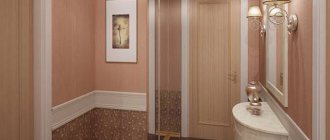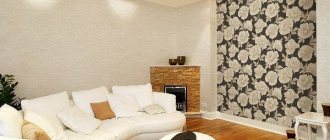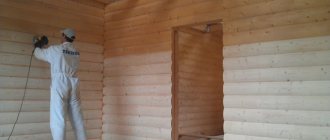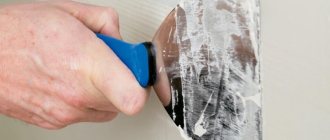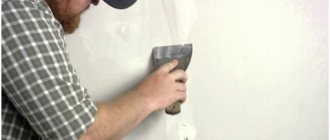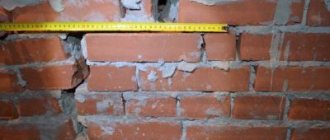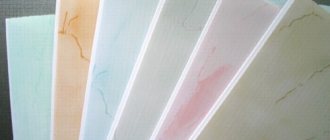Life moves quickly and unnoticed. It would seem that the renovation was only recently done, but it’s already peeled off here, worn out there, and here the stain is in the most visible place. And now the thought comes about new troubles regarding repairs and gluing the walls.
Before you start updating, you need to look and think about what can be done with the old wallpaper without causing a blow to the family budget.
What is applied to the walls instead of wallpaper?
How to replace wallpaper: top 10 alternative materials
- Decorating a space using decorative plaster
- Wall decoration with Venetian plaster
- Silk plaster or “liquid wallpaper”
- Mosaic paint instead of wallpaper
- Textured wall decoration
- Fresco instead of wallpaper: interesting solutions
- Using flexible sandstone on walls
- Flexible slate in the interior
21 Jun
2022 Interesting materials:
How to calculate points for retirement in 2022? How to calculate sick leave if the length of service is less than a year? How to calculate maternity benefits if you have worked for 1 year? How to calculate calories for yourself? How to calculate calories for weight loss? How to calculate compensation if there is no average earnings? How to calculate personal income tax for individual entrepreneurs on the Usn? How to calculate the volume for a transport company? How to calculate the sales floor area for UTII? How to calculate heart rate for fat burning?
Full painting
In order to radically change the color of the walls, water-based paint is suitable.
With it you can update wallpaper from any material.
For a textured coating, it is better to choose a roller with long pile.
Fingerprints and scuff marks
If fingerprints on wallpaper can be removed simply with a colorless soft eraser, then abrasions are a more complex problem. The only way to deal with them is to use a vinyl sticker or a decorative sticker. With its help, you will reliably hide the problem area and get an updated interior.
There is no need to rush to immediately begin renovating the entire room if defects appear in certain areas of the wallpaper. There are simple ways to extend their lifespan for a couple more years.
Inscriptions
Children often paint canvases with pens or colored pencils. It is not necessary to replace them - there are several options for cleaning the inscriptions.
Important! Inscriptions with a pen can be easily wiped off with a solution of citric acid or ammonia.
Durable wallpaper can be gently rubbed with baking soda until the writing disappears. Vinyl wallpaper can even be cleaned with a brush, however, you need to do it without much pressure. If the trim has been painted, the easiest way is to touch up the defective area again.
Updating without hassle
If the wallpaper has peeled off or is damaged only in some places, and the rest look pretty good, you can limit yourself to minor repair work with your own hands.
To do this, you need to inspect the coatings and take note of all problem areas. It can be:
- minor damage and abrasions, perhaps the canvas is bent or frayed at the outer corners;
- there are noticeable greasy stains in prominent places;
- the wallpaper has become bubbling or the joining seams have come apart and are warped in the corners;
- little artists learned to draw.
Troubleshooting
If the outer corners are bent or frayed, you can use a plastic corner that matches or contrasts with the main wallpaper. It is easy to glue it with your own hands by choosing the appropriate adhesive composition.
If a large area is scuffed or damaged, you need to cut out the piece of wallpaper needed for gluing from the remaining piece of wallpaper after the repair, carefully aligning it according to the pattern. Carefully cut out the old one with a sharp knife, and glue the new, selected one.
If there is no wallpaper left, then there is a way out in this case too. You can glue a colorful sticker and paint it, framing it with moldings.
In case of greasy stains, washable wallpaper is treated with a sponge, using a soap solution or other grease remover. If they are present on paper wallpaper, they are treated with salt or starch and then brushed off with a soft brush.
Advice! White clay used for cosmetic purposes removes dirt well. It is diluted to the state of liquid sour cream and applied to the stain for a day. Then brush off with a soft brush or cloth. The main thing in this case is not to damage the wallpaper.
If bubbles form on the wallpaper, they should be pierced with a needle and all the air should be expelled. Then dilute the adhesive solution a little thinner than usual and pump it under the wallpaper with a syringe. Then carefully smooth the surface.
If the joints have come apart, the easiest way is to buy a special compound in tubes. They are sold in building materials stores and are inexpensive. How to update the walls is shown in the photo:
If there is loose wallpaper in the corners, it is best to spread it apart, clean off any stuck pieces of putty, coat it twice at intervals of 5-10 minutes, and when the base gets wet and becomes elastic, glue it to the old place, trying to press it tightly and without bubbles to the wall.
After the creativity of little ugly people, drawings with a felt-tip pen, pencils or marker are often left behind.
An ordinary pencil can be easily erased with an eraser. You can try to remove serious creativity with felt-tip pens with alcohol or gasoline.
Attention! It is necessary to test the liquid on a small piece of wallpaper, so that in case of failure you do not smear everything on the wall.
In hardware stores you can purchase special wet wipes for removing stains or liquid for removing stains. All these methods are good for updating, with minor damage, old wallpaper. How to update the interior is shown in the photo:
Surface preparation
To prepare the surface you will need the following tools:
- putty knife;
- brush;
- bucket;
- rag;
- stationery knife.
You will also need:
- ordinary tap water;
- acrylic putty;
- wallpaper glue.
First you need to visually inspect the wall. It should not have large blisters, serious peeling or other large-scale defects. When you are convinced that there is nothing of the kind, you can move on to a more careful study. Here you need to look for smaller irregularities: minor peeling, protrusions in the seam area, small breaks. Here's what to do if they are found:
- breakthroughs - carefully cover with acrylic putty;
- glue small tears (or tear them off completely and treat their locations with putty);
- Extending joints should be glued with wallpaper glue;
- if the joints are uneven, remove the excess with a utility knife; if something comes off during work, glue it back.
Decorative stickers
Decorative stickers will help transform the entire wall.
Now they are sold in many stores, so finding them will not be difficult.
They look especially interesting on plain wallpaper.
Instead of stickers, colored Washi Tape will also work.
With its help you can create an interesting ornament.
Old wallpaper in a new interior
You can consider several more options on how to update old wallpaper in the interior without resorting to painting.
Most often, damage occurs on the lower part of the wall. In this case, you can cut out large, funny appliqués from old pieces of wallpaper left over from previous renovations and carefully stick them on the wall. These could be unusual animals in a nursery or an urban look in a living room or bedroom.
Often they use not only old obi, but also bright fabrics. They can match or contrast with the rest of the room's decor. The main thing is that it fits into the interior of the room.
Such applications look especially good in a children’s room, and you can involve a child in making “wall paintings”.
Mold on and under wallpaper
If the room is very humid, then such unpleasant “neighbors” as fungus and mold may appear on the surface of the wall. It is not at all easy to evict both of them, but it is possible. It's easy to spot mold under wallpaper - dark spots will appear on it.
Mold on wallpaper - only plywood will help
Unfortunately, such wallpaper will have to be completely removed in the place where it covered the fungus. And the wall itself will need to be thoroughly cleaned of fungus, using all kinds of antiseptics. And fresh wallpaper (it’s good if you have pieces to match) should be glued with glue containing antibacterial substances.
Important! Remember that mold in an apartment is not only a source of unpleasant odors, but also an organism that harms your health! Therefore, it is imperative to get rid of it.
How often do you need to re-glue wallpaper?
Advice As such, wallpaper does not have an expiration date, which means that you need to re-glue it as needed or based on your own desire. Among the main reasons for wallpapering are:
- spots;
- discoloration;
- marriage;
- desire to change the design;
- choose wallpaper to match new furniture;
- major renovation.
The frequency of changing the appearance of the walls largely depends on the use of the room and on who lives in it. Wallpaper in an apartment where children or pets live will have to be changed more often than a neat, lonely housewife. The right choice of high-quality modern wallpaper can protect you from a lot of problems that will make replacing them inevitable.
It is best to choose eco-friendly, safe, UV-resistant, washable wallpaper that can be cleaned if dirty.
On average, paper wallpaper needs to be changed every 5 years, and more expensive and modern options - less often. All wallpapers have their advantages and disadvantages. The most environmentally friendly wallpapers are made from bamboo, and models made from cork have proven themselves to be resistant to fading and the occurrence of fungus and mold.
Type recommendations
The best way to glue wallpaper that has peeled off at home depends not only on the size of the problem area, but also on the type of finishing materials.
Non-woven
The most popular type. The good thing is that the glue is applied only to the wall. This is true both for the initial gluing and if you need to re-glue peeled wallpaper. However, if the canvas is stubborn, you can also coat it with glue - it will become softer and stick better.
Important! We recommend avoiding getting glue on the outer covering. Otherwise, you should wipe the product very carefully so as not to damage or erase the pattern.
Vinyl
With your own hands
If you decide to update the interior by painting it yourself, then first you need to take care of the necessary tools:
- a paint roller with several “coats”, depending on the texture of the wallpaper;
- brushes for painting hard-to-reach places;
- paint tray.
Painting begins with hard-to-reach places, then all remaining surfaces are covered with a roller and the first layer is allowed to dry. If the paint has applied well and the old layer, gaps and unpainted areas are not visible, then this can be enough. If not, then it is better to apply another layer.
Combination
If the lower or upper part of the wallpaper is completely damaged, you can join it with the remains of other wallpaper.
To do this, you need to stick masking tape around the entire perimeter of the area being replaced and use a knife to remove a piece of unsuitable fabric.
Glue new wallpaper in its place.
First actions
The nuances of washing different types of wallpaper
Before you begin the struggle to remove dirt from the wallpaper, you need to determine how to wash it.
- On a paper base with a varnish coating. Usually this type is chosen for the kitchen or hallway. It is not allowed to use hard objects when cleaning, as they are “afraid” of mechanical contact.
- Vinyl is a special foam base, fixed with an inhibitor, with a very delicate coating. For washing, use only a soft sponge.
- Screen printing is the addition of fabric fibers during production. These wallpapers are thin, but quite durable. They are not afraid of direct contact, but the choice of cleaning products must be approached carefully; not everyone can withstand it. This type of coating reacts to many chemicals, so it is better to use a regular soap solution when washing. And only if absolutely necessary, use other means, after conducting a test.
- Vinyl, produced by hot stamping with a non-woven backing. Such wallpapers are recognized as the most resistant to various aggressive influences. They are not afraid of washing and cleaning using special products.
Marking
When buying wallpaper, you need to pay attention to the markings that each roll is equipped with. It contains encrypted information about care
One wave means that such wallpaper cannot be washed with various detergents.
They require only moderate cleaning with a damp cloth. If two waves are drawn, then you can use a soap solution. Three waves - clean with a variety of preparations, being careful only when using chlorine-containing bleaches. If, in addition to the waves, a comb is also drawn, then this type of wallpaper can withstand even intensive cleaning and washing, including the use of brushes and a vacuum cleaner.
Testing
It is not always possible to save a shortcut with this important information. In this case, you need to do a durability test using a piece of wallpaper in a secluded corner
You should check the color fastness when wet, wait until it dries completely and make sure that the paper layer has not deformed and there are no streaks left after using the cleaning agent.
And only after successful completion of all procedures can you calmly begin the main work of removing contaminants, knowing that there will be no unexpected surprises.
But even if the wallpaper has successfully passed various tests, you should not rub it too vigorously, so as not to tear off the top protective layer. It is also not recommended to be too zealous with water, they can simply become limp and spread apart.
If, after using cleaning products, you were not immediately successful and you need to repeat the procedure, then before trying again you should make sure that not only the top layer, but also the inner layer is completely dry.
You cannot use improvised means such as a hair dryer or fan heater to speed up the drying process. This may cause the wallpaper to warp. Drying should occur naturally, without drafts, so that they do not come off.
Erase a drawing
If there are whitish spots on the wallpaper, the pattern has become discolored, you will have to re-glue the strip or repair the defects with patches. Stickers, stickers, posters, framed photographs and paintings will also help get rid of the problem and update the interior - they can be placed on the problem area.
The pattern on the wallpaper has worn off
Repaired wallpaper will last for a long time, because maintaining it in a beautiful and clean condition is not so difficult.
Stick self-adhesive pictures
This option is especially good for children's rooms, whose young inhabitants love to use the walls for self-expression. If you don’t want the walls of the room to be decorated with your child’s artistic creations, go to the store with your child and choose suitable self-adhesive pictures. These can be drawings of plants, animals, bright educational posters or entire landscapes. The child will definitely be satisfied with this transformation of his little world.
A self-adhesive tree in the shape of a tree with an unusual floral design can fit perfectly into the interior of your living room. By hanging photographs of your relatives on the branches of this improvised plant, you can create a creative semblance of a family tree.
Refresh wallpaper using chemicals, extreme cases
The use of a variety of chemicals to renew or restore old trellises should only be used as a last resort when other methods do not work.
If you have the opportunity to choose between sealing the damaged areas or using unknown chemicals, choose the first option. It is safer and gives 100% results. In addition, it is not possible to use solvents, stain removers or homemade multicomponent mixtures everywhere; for example, it is better not to use such chemicals in a children's room.
One of the common problems with wallpaper aging is the impregnation of the paper base of the wallpaper with all sorts of volatile substances. For example, in the kitchen this could be fumes from the stove. When natural gas burns and cooks, a fairly large amount of “fat” gases are formed, which settle on the ceiling and the top of the walls. The colors of old trellises fade and become darker with a layer of dirt. In this case, the ceiling and walls can be treated with a mixture of isopropyl alcohol, distilled water and window cleaner. For updating and cleaning, use a dry, clean microfiber cloth. The surface of the decor is sprayed and wiped or blotted with a napkin, depending on the height of the pattern relief.
A similar mixture can also be used if the decor needs to be updated and freed from any ingrained odor. In this case, use a wide cotton napkin, onto the surface of which a mixture with a three-fold reduced alcohol content is applied. A moistened napkin is applied to the surface of the wallpaper and lightly, without much effort, ironed with a warm iron. If you are allergic to the smell of alcohol, you can replace it with vinegar. Processing is carried out in several passes, and you should not strive to update and achieve maximum effect in the first processing. They do not steam it with an iron, but only heat the mixture, after which they quickly remove the napkin from the wall. At the same time, an unpleasant atmosphere is established in the room, so the room is periodically ventilated.
Depending on the nature of the contamination, old trellises can be updated using “compresses” of white clay or finely ground charcoal. A layer of material is wrapped in a napkin and, after applying it to traces of foreign organic liquids, heated with an iron. Sometimes it is recommended to apply a layer of white cosmetic clay slurry to the stain. After drying, the layer is carefully scraped off the renewed surface.
Often, mixtures based on isopropyl alcohol and pure gasoline help to renew old trellises from grease stains, provided that the stains were caused by touching hands or parts of clothing.
You can use a gasoline-acetone mixture if stains on the surface are caused by oil, grease, shoe care products, various cosmetic creams and balms, or a ballpoint pen. Contaminants will be removed, but there is a risk of damage to the paint or polymer coating of the wallpaper.
More ways to update
There are many ways to use old wallpaper and update the interior of a room.
For example, pick up several rolls that match the old ones and glue one of the walls, leaving the rest with the old wallpaper. Or make it in the form of trellises, alternating old with new.
Broken joints that cannot be restored can be designed in the form of rhombuses or other geometric shapes by cutting out old wallpaper, and instead make a geometric appliqué in contrasting pieces. It will look original and refresh the room.
Wallpaper with an original design can be made in the form of a picture by gluing an interesting fragment onto cardboard and framing it with beautiful moldings.
In case of contamination or damage to the lower parts of the walls, carefully cut off the bottom and remove it; instead, stick on matching wallpaper companions in the form of panels.
Many ideas on how to use old wallpaper in the interior can be found in the following video:
Recommended Posts
3d wallpaper for the living room + photo
How to properly glue wallpaper on drywall with and without putty…
How to hang wide wallpaper
Beige wallpaper in the interior
Brick wallpaper in the hallway and corridor
Erismann wallpaper in the interior

